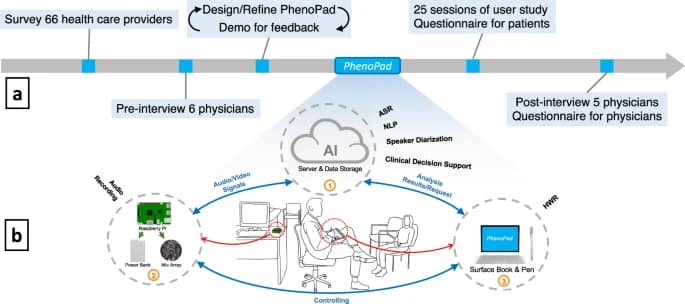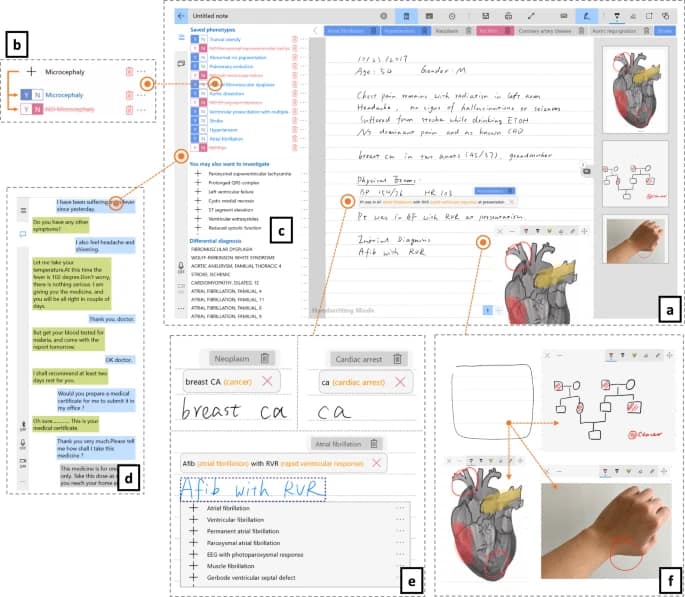
Precise clinical documentation is essential to making well-informed decisions in the complex field of healthcare, guaranteeing that each patient’s path is directed with care and accuracy. But the age-old difficulty of striking a balance between thorough note-taking and significant patient-clinician interaction continues to be a formidable issue.
Fundamentally, the problem is with the time-consuming and frequently out-of-date techniques used to collect patient data. Clinicians are often forced to take notes while working in a busy healthcare setting where every second counts. This takes their valuable time away from attending to the patient. This puts the standard of care in jeopardy and increases the possibility of mistakes, oversights, and compromised data integrity.
The problem of accurate clinical documentation has far-reaching implications. It encompasses:
- Workflow concerns: Current workflows for documentation present a daily challenge for clinicians. The laborious process of taking notes by hand takes away from their ability to give patients the superior care they need.
- Detriment to patient-clinician interaction: The patient-clinician relationship is negatively impacted when doctors become lost in their notes. Informed treatment plans and accurate diagnosis depend on openness and trust, both of which are undermined by decreased engagement.
- Data integrity issues: Manual documentation may contain mistakes, omissions, or ambiguities that could influence decisions about future medical care and how patients will fare.
PhenoPad: fusing technology with healthcare precision
PhenoPad appears as a link between conventional note-taking techniques and cutting-edge AI technologies in the dynamic field of healthcare, where precision and effectiveness are critical. This creative solution leverages Natural Language Processing (NLP) and Automatic Speech Recognition (ASR), two essential AI components, backed by a user-friendly interface.

Automatic Speech Recognition (ASR) – Translating spoken words into precise text
ASR, a technology that proficiently converts spoken language into written text, is the foundation of PhenoPad’s artificial intelligence capabilities. The technological innovation that powers PhenoPad is designed especially for use in medical conversations, meaning that even the most complex medical terminologies are identified and captured. To record patient visits in real-time, this procedure is essential. With a finely tuned vocabulary of 82,000 specific medical terms, the ASR used in PhenoPad is based on a vast knowledge base derived from 2 million medical terms.
Natural Language Processing (NLP) – Understanding and enhancing human language
The second foundational element of PhenoPad’s AI system is NLP. Making computers comprehend, interpret, and produce human language is the main goal of this branch of artificial intelligence. NLP is essential in the PhenoPad context because it helps process the text that ASR transcribes, which is a crucial step in supporting clinical decision-making.
Stylus and Tablet Device – Effortless interaction and digital documentation
Clinicians can easily navigate PhenoPad’s hardware with the help of its intuitive stylus and tablet device. This stylus replicates the conventional paper-and-pen method by functioning as a digital pen, making it easy for clinicians to take notes. But what makes it magical is its digital power. Important patient data can be easily stored and retrieved thanks to the stylus’ instantaneous digital transformation of notes.
Cloud Server – The powerhouse behind PhenoPad
PhenoPad’s computational powerhouse is the cloud server. It performs a number of vital functions, such as clinical decision support, medical term extraction, and speech recognition. Additionally, the cloud server acts as a central repository for information that is generated and captured, making it simple for clinicians to access and retrieve data.
Medical term extraction and abbreviation clarification: precision in healthcare terminology
Equipped with state-of-the-art instruments such as the Neural Concept Recognizer (NCR), PhenoPad thrives at extracting medical terms. It carefully finds and extracts pertinent medical terms from the vast ocean of conversation, ensuring that important information is not overlooked. PhenoPad also provides explanations for abbreviations, which makes the notes thorough and unambiguous. This eliminates confusion and guarantees the accuracy of the data that is recorded.
Healthcare professionals gave PhenoPad a resounding approval, praising both its user-friendliness and its beneficial effects on patient engagement. The use of audio and video recording was deemed comfortable by 92% of participants who are patients. One of the physicians said, “It was absolutely out of the way and was just fine for both patients and myself,” during the semi-structured interview. “Devices should be smaller and less visible,” said another physician.
The integration of these technological elements in PhenoPad offers a revolutionary approach to precise clinical documentation. It improves documentation process efficiency and raises the accuracy and lucidity of the data that is captured, which leads to better health outcomes. The complexity of PhenoPad’s technology demonstrates how AI has the power to completely transform healthcare, making it more patient-centered, effective, and widely available.

Challenges in Implementing PhenoPad
Even though PhenoPad promises to revolutionize clinical documentation, there are some practical issues and barriers that need to be taken into consideration. There are special challenges in implementing this advanced solution, especially in environments with limited resources. Here, we explore these issues and—more importantly—tailored, accurate, and creative solutions that are inherent to the technology and the problem:
Domain specificity
- Challenge: The current tools available in PhenoPad are mainly designed for genetic diseases. More work is needed to expand and modify them to accommodate a wider range of clinical scenarios.
- Solution: Provide a modular and adjustable PhenoPad system that enables medical professionals and institutions to modify and customize it to meet their unique clinical requirements. Machine learning models can be trained and adjusted to suit different medical specialties.
Integration complexities
- Challenge: To fully utilize PhenoPad, seamless integration with current systems such as Electronic Health Records (EHR) is essential. These integrations, nevertheless, may be difficult, expensive, and time-consuming.
- Solution: Create standardized APIs (Application Programming Interfaces) and data-sharing rules to make it easy for PhenoPad to connect with Electronic Health Record (EHR) systems. Encourage EHR providers to use these shared rules, like a common language, to simplify and speed up the connection process. This way, PhenoPad can work seamlessly with EHR systems, ensuring healthcare professionals can efficiently use it alongside their existing tools.
Privacy and data security
- Challenge: Data security and privacy must always be prioritized when working with sensitive medical data. Cloud-based solutions, such as PhenoPad, have to protect patient privacy and confidentiality while navigating the complicated world of healthcare data regulations.
- Solution: Protect patient data by implementing strict access controls and cutting-edge encryption protocols. To provide patients with greater control over their medical data, investigate the usage of decentralized and blockchain-based data management systems.
Low-resource settings
- Challenge: It is difficult to implement a solution such as PhenoPad in areas with poor hardware resources, inconsistent Wi-Fi coverage, and little technological infrastructure.
- Solution: Provide PhenoPad with an offline mode so it can operate without a constant internet connection. Provide more manageable iterations of the hardware specifications so that the solution can be implemented in resource-constrained areas.
PhenoPad may improve global health equity by tackling these issues with context-specific solutions, which makes this potential even more apparent. The combination of state-of-the-art technology and focused approaches is essential for overcoming these challenges and guaranteeing that the advantages of precise clinical documentation are felt worldwide, regardless of resource constraints. The promise of revolutionary healthcare equity illuminates the difficult path ahead.
Are you ready to revolutionize healthcare with PhenoPad? How do you envision its potential in your clinical setting? Join the conversation and embark on this transformative journey toward global health equity.
Source article: https://www.nature.com/articles/s41746-021-00555-9#Sec2
Disclaimer: Please note that the opinions, content, and analysis in my posts are entirely my own and do not reflect the views of any current or past employers or institutional affiliations. These posts, based solely on publicly available information, are for informational purposes and should not be taken as professional advice. All insights and conclusions are my viewpoints and should not be considered representative of any organizations I am or have been associated with. This content is not endorsed by, nor does it represent the stance of any affiliated entity.





